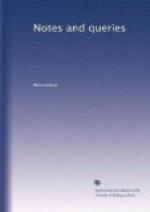S.W. SINGER.
March 26. 1850.
* * * * *
THE WATCHING OF THE SEPULCHRE.
Inquired about by “T.W.” (No. 20. p. 318.), is a liturgical practice, which long was, and still is, observed in Holy Week. On Maundy Thursday, several particles of the Blessed Eucharist, consecrated at the Mass sung that day, were reserved—a larger one for the celebrating priest on the morrow, Good Friday; the smaller ones for the viaticum of the dying, should need be, and carried in solemn procession all round the church, from the high altar to a temporary erection, fitted up like a tomb, with lights, and the figure of an angel watching by, on the north side of the chancel. Therein the Eucharist was kept till Easter Sunday morning, according to the Salisbury Ritual; and there were people kneeling and praying at this so-called sepulchre all the time, both night and day. To take care of the church, left open throughout this period, and to look after the lights, it was necessary for the sacristan to have other men to help him; and what was given to them for this service is put down in the church-wardens’ books as money for “watching the sepulchre.” By the Roman Ritual, this ceremony lasts only from Maundy Thursday till Good Friday. This rite will be duly followed in my own little church here at Buckland, where some of my flock, two and two, in stated succession, all through the night, as well as day, will be watching from just after Mass on Maundy Thursday till next morning’s service. In some of the large Catholic churches in London and the provinces, this ceremony is observed with great splendour.
DANIEL ROCK.
Buckland, Farringdon.
Watching the Sepulchre.—If no one sends a more satisfactory reply to the query about “Watching the Sepulchre,” the following extract from Parker’s Glossary of Architecture (3rd edit. p. 197.) will throw some light on the matter:—
“In many churches we find a large flat arch in the north wall of the chancel near the alter, which was called the Holy Sepulchre; and was used at Easter for the performance of solemn rites commemorative of the resurrection of our Lord. On this occasion there was usually a temporary wooden erection over the arch; but, occasionally, the whole was of stone, and very richly ornamented. There are fine specimens at Navenby and Heckington churches, Lincolnshire, and {355} Hawton church, Notts. All these in the decorated style of the fourteenth century; and are of great magnificence,




